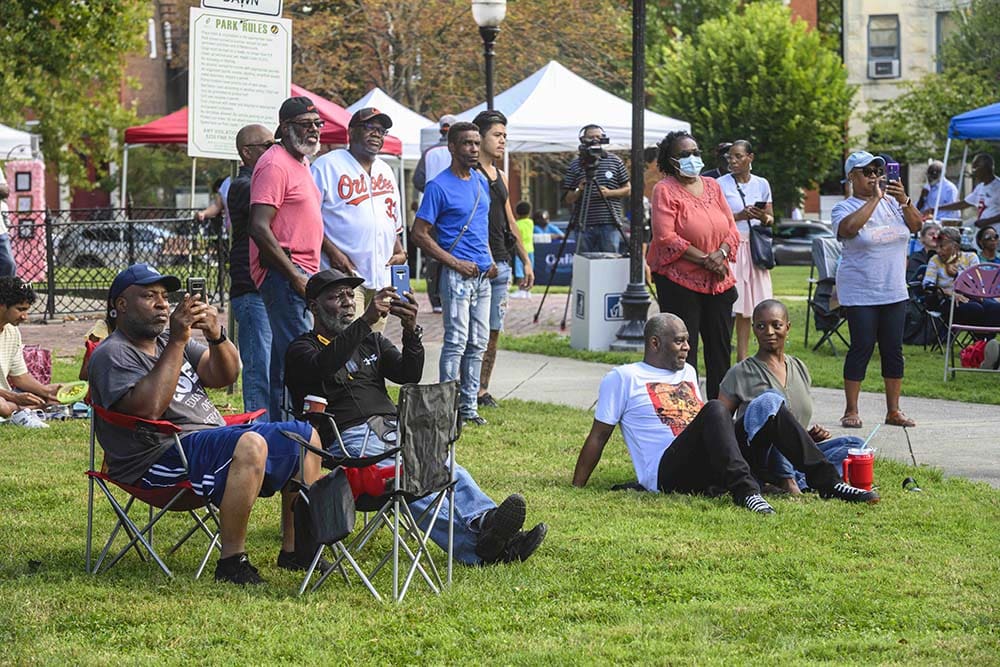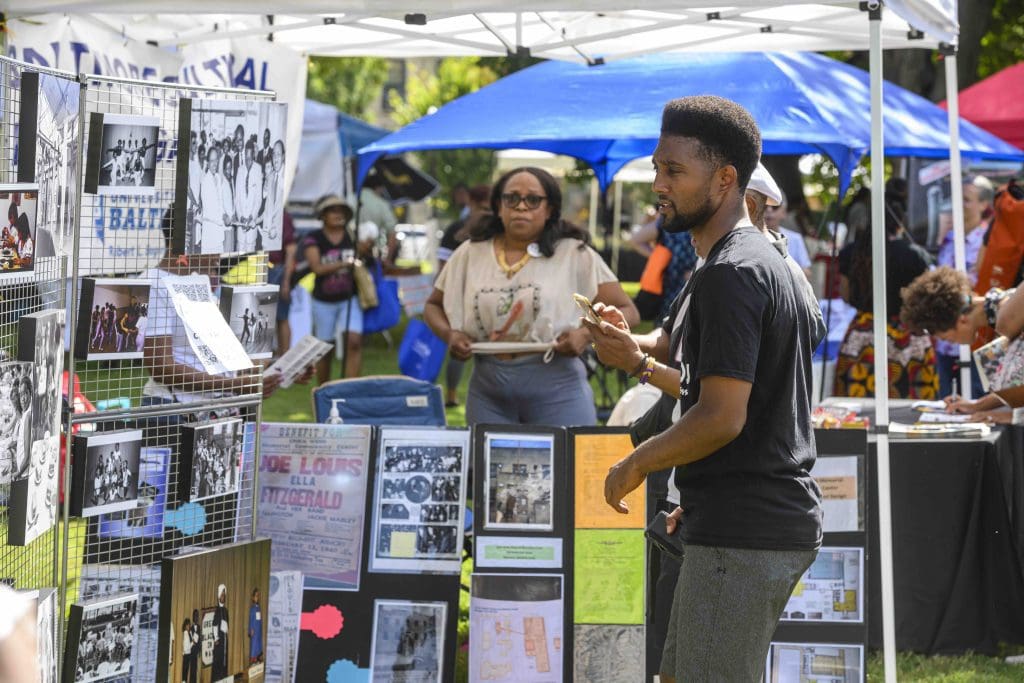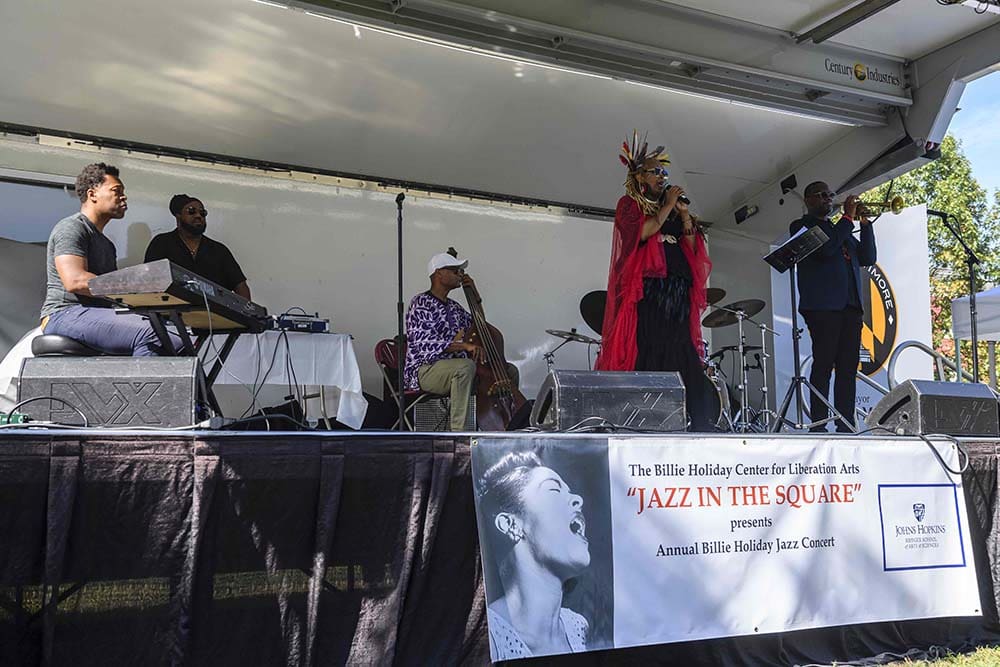“Man, I know what you are trying to do!” With those words, Ray Rice, a lifelong resident of Sandtown, congratulated Professor Lawrence Jackson, the director of the Billie Holiday Center for Liberation Arts. It was the conclusion of the annual “Jazz in the Square” concert. Attired in the ancient garb of the Avenue, an oxford shirt of white linen and a plaid driving cap, Rice clarified his observation about the afternoon event that had both the quality of a family reunion, a coming-out-party, and an occasion for deep historical inquiry and recovery. In its fourth year, “Jazz in the Square” has begun to symbolize precisely such a moment of eagerly anticipated reunion, renewing fellowship, as well as reconciliation. It is designed to foster a new kind of community, one that includes and celebrates Baltimoreans who have remained in black neighborhoods, those with longstanding ties through family and worship, and those employed by or studying at Johns Hopkins. Jackson replied to his new friend, “You have read my mind and made the afternoon for me,” acknowledging the genuine perceptiveness of the comment.
Since 2019 Jackson’s Billie Holiday Center for Liberation Arts has conducted the annual concert featuring a trained jazz vocalist singing Holiday standards and accompanied by famed Peabody Conservatory musicians Nasar Abadey and Sean Jones (the director of the Jazz Studies program there). On September 10, 2022, local star Navasha Daya took the stage as headliner. Wearing a red shawl and feathered headdress, Daya, a local favorite keen to perform Holiday-authored songs, played two sets between 3pm and 5:30pm. The crowd approvingly responded to her versions of standards like “Fine and Mellow” and “Billie’s Blues,” but also less well-known numbers like “Tell Me More and More and Then So,” a slow tune that the band played in “tuba two,” or, hot.


The concert opened with straight-ahead music from Peabody student band “Kenyatta,” headed by trumpet player Cyrus Mackey and half-a-dozen other Peabody students, including percussionist Devron Dennis, a graduate of Baltimore’s School for the Arts. The ensemble played for twenty minutes and then the mayor of Baltimore, Brandon Scott, welcomed the crowd. The Dean of the Krieger School of Arts and Sciences, Chris Celenza, and his wife professor Anna Celenza, a jazz scholar offering classes on the music of Miles Davis, both enjoyed the afternoon’s performances.
Lady Brion, Baltimore’s reigning poetess laureate, served as the vibrant MC of the afternoon. Adorned in a dress of vivid azure, she interspersed her crisp wisdom and laceratingly beautiful poems throughout the afternoon. More than 350 people grouped around the Baltimore City Mayor’s stage in lawn chairs in the historic square, which had been home to Federal troops during the Civil War, and sits due west of Jackson’s church, the historic St. James of Lafayette Square. During the intermission between Daya’s two five-song sets, the BHCLA’s artist-in residence Brinae Ali offered a compelling tap dance in the tradition of Baltimore’s best-known hoofer, “Baby” Laurence, accompanied by the blue-noted accents of her partner, trumpeter Sean Jones. Sonic interludes were contributed by internationally famous house music disc jockey Ian Friday, a Wesleyan University class mate of professor Jackson’s, who came down from Brooklyn for the afternoon.
During the middle of the performance, Jackson read a paragraph from a new work that compared the eerie similarities of Baltimore and New Orleans. “I try to share with all of the performers the deep roots to the jazz and blues,” he explained, “found in the spirituals, work songs, field hollers, and syncopated rags and spasms of 19th century popular music. The concert offers a venue to appreciate basically acoustic music from the center stage and in a neighborhood most recognizable to Holiday herself. The irony is that Holiday, who had a lacerating childhood of poverty and abuse, knew a more fully racially integrated world than the one that is recalled by living black Americans in their 80s and 90s, let alone contemporary residents whose memories are so profoundly shaped by the disinvestment and capital regression after the 1968 response to the assassination of Martin Luther King Jr.”
As partly an act of neighborhood return, revitalization, and remaking, the concert is also an opportunity to showcase the BHCLA’s efforts at historical and archival preservation. A cluster of folding tables, manned by new arrivals to the Center and the Johns Hopkins library as part of the Mellon Foundation funded Inheritance Baltimore program, offered information about the group’s “Celebrate Educate Preserve” efforts, including its mobile digitization van. Photographer John Mayden, one of the first artists approached by Jackson in the preservation effort that launched BHCLA and which included the publication of Mayden’s achingly handsome photography in the award-winning book Baltimore Lives by the Johns Hopkins University Press, sat at a table with the Sheridan Library’s Kurrelmeyer Curator Gabrielle Dean. Community groups active in the Harlem Park and Sandtown neighborhoods, like the Citizens Policing Project, devoted to advancing the “true perspective of residents” on the touchstone issue of policing and its budget in Baltimore, and Jubilee Arts, a Pennsylvania Avenue arts space offering classes in visual arts, dance and ceramics for local youth.
University of Baltimore’s librarian and curator of public engagement Angela Rodgers-Koukoi staffed an exhibit of Baltimore photographs selected from summer arts programs during the early 1970s and featuring ballet, music, and theater workshops. She supervises the collaborative archival work of new BHCLA community fellow Jess Douglass. Rodgers-Koukoi pointed to the “sociocultural benefits” of such a large community gathering in the historic square. “We are reclaiming our history through the community archives program, uncovering hidden narratives, and adding art and cultural recordings not previously included in the archive. Baltimore residents have historically benefited from live concerts, and BHCLA has played a vital role in revitalizing this tradition.” The Eubie Blake Center, represented by its director Derek Price, is another local archive and exhibition space benefiting from the collaborative work of the new fellows.
BHCLA collaborates with two groups currently transforming the physical landscape of Upton and Druid Heights the Beloved Community Services Project and Afro Charities, the non-profit fundraiser and archive of the Afro-Americannewspaper. Led by Rev. Dr. Alvin C. Hathaway, Beloved Community is rehabilitating historic Division Street Henry Highland Garnett Elementary and turning it into the Thurgood Marshall Amenities Center. In the 4,000 square foot building and alongside the Judge Alexander Williams Jr. Center for Justice, Ethics, and Education, the Billie Holiday Center will have a field office, home for its Elder-in-Residence and Artist-in-Residence, and host of its Helena Hicks Speakers Series, featuring Johns Hopkins University faculty. Alumni BHCLA community arts fellow Deyane Moses has gone on to take fulltime work as librarian at Afro Charities. AC Director Savannah Woods greeted crowds throughout the “joyful afternoon filled with music, history and community building… a perfect venue for the Afro Charities team to share the AFRO Archives with the public, and to celebrate the vibrancy of our neighborhoods.”
Christian Allen, whose extended family has regularly attended the concerts and who grew up in the Warwick and Walbrook Junction neighborhoods, thought that the concert was “a trip in a time machine that transported the audience to a time and a place where we were a community based in respect and love.” The last person on the microphone on Saturday, Jackson thanked his mother Verna, a graduate of PS#120 on Pennsylvania Avenue, Booker T. Washington Jr. High on McCulloh Street, and Frederick Douglass Senior High, then at the corner of Baker and Calhoun streets. He concluded simply, “I dedicate this work to you, Mom.”

